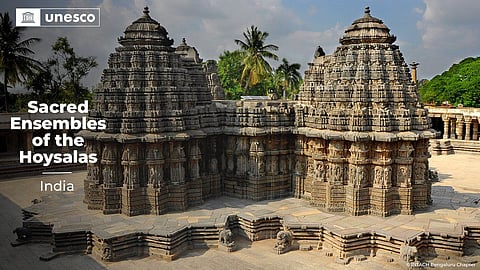

BENGALURU: The unique architectural marvels of Karnataka — the 12th century Hoysala era temples of Belur, Halebidu and Somanathapura in Hassan and Mysuru districts on Monday — were recognized as the UNESCO World Heritage Site: 42nd in India and fourth site in Karnataka to get the world heritage tag.
The ‘Sacred Ensembles of the Hoysals’ often described as ‘Poetry carved in Stone’ at the global level was recommended by the Centre’s ministry of culture as India’s latest nomination for consideration as a World Heritage Site for the year 2022-23.
The 45th session of the World Heritage Committee of UNESCO which met in Riyadh, Saudi Arabia on Monday approved India’s recommendation of the ‘Sacred Ensembles of the Hoysals’ comprising three temples — Channakeshava temple at Belur, Hoysalesvara Temple in Halebidu in Hassan district and Kesav temple at Somanathpur of Mysuru district as the latest addition to the list of World Heritage Sites.
In fact, the temples of Belur and Halebidu have been on Unesco’s world heritage tentative list since 2014.
Previously, two other groups of monuments of Karnataka at Hami (1986) and Pattadakal (1987) along with the Ecological hotspot Western Ghats (2012) had the coveted status.
The Indian delegation present during the session thanked the global community for supporting the nomination and presenting India with a festive gift on the occasion of Ganesh Chaturthi.
On the sidelines of Unesco’s announcement, A Devaraju, commissioner, department of archaeology, museums and heritage told TOI that it is indeed a happy moment for Karnataka.
“It has been a pride moment for Karnataka and the heritage, and culture that the state represents. This has been a long pending credit for this group of monuments. Also, this will bring us a lot of challenges ahead,” he said.
It can be recalled that on September 14, 2022, Tiong Kian Boon of Malaysia, who was nominated as an expert by the International Council of Monuments and Sites visited Beluru, Halebidu and Somanathpur for a critical evaluation of India’s recommendation.
“The excellence of the sculptural art underpins the artistic achievement of these temple complexes, which represent a significant stage in the historical development of Hindu temple architecture,” Unesco said in its statement.
The Hoysala rulers ruled over parts of Southern India from the 11th Century to the 14th Century with Halebidu (Dwarasamudra) as their capital.
The Hoysala era was considered an important period in the development of South Indian art, architecture and religion. About 100 plus surviving temples are scattered across Karnataka till date.
Source: TOI
